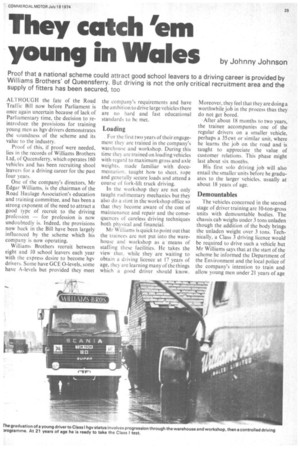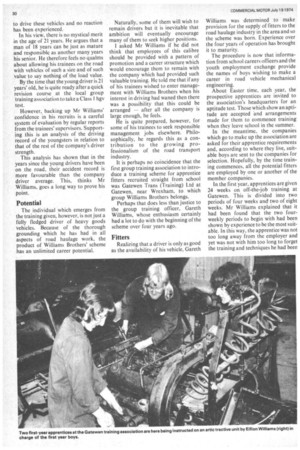They. catch 'em young in Wales
Page 31

Page 32

Page 33

If you've noticed an error in this article please click here to report it so we can fix it.
Proof that a national scheme could attract good school leavers to a driving career is provided by Williams Brothers' of Queensferry. But driving is not the only critical recruitment area and the supply of fitters has been secured, too
by Johnny Johnson
ALTHOUGH the fate of the Road Traffic Bill now before Parliament is once again uncertain because of lack of Parliamentary time, the decision to reintroduce the provisions for training young men as hgv drivers demonstrates the soundness of the scheme and its value to the industry.
Proof of this, if proof were needed, lies in the records of Williams Brothers Ltd, of Queensferry, which operates 160 vehicles and has been recruiting shoal leavers for a driving career for the past four years.
One of the company's directors, Mr Edgar Williams, is the chairman of the Road Haulage Association's education and training committee, and has been a strong exponent of the need to attract a good type of recruit to the driving profession — for profession is now Undoubtedly is. Indeed, the provisions now back in the Bill have been largely influenced by the scheme which his company is now operating.
Williams Brothers recruit between eight and 10 school leavers each year with the express desire to become hgv drivers. Some have GCE 0-levels, some have A-levels but provided they meet
the company's requirements and have the ambition to drive large vehicles there are no hard and fast educational standards to be met.
Loading
. For the first two years of theirengagement they are trained in the company's warehouse and workshop. During this time they are trained on loading vehicles with regard to maximum gross and axle. weights, made familiar with documentation, taught how to sheet, rope and generally secure loads and attend a course of fork-lift truck driving. In the workshop they are not only taught rudimentary mechanics but they also do a stint in the workshopoffice so that they become aware of the cost of maintenance and repair and the consequences of careless driving techniques both physical and financial.
Mr Williams is quick to point out that the trainees are not put into the warehouse and workshop as a means of staffing these facilities. He takes the view that, while they are waiting to obtain a driving licence at 17 years of age, they are learning many of the things which a good driver should know. Moreover, they feel that they are doing a worthwhile job in the process thus they do not get bored.
After about 18 months to two years, the trainee accompanies one of the regular drivers on a smaller vehicle, perhaps a 35 cwt or similar unit, where he learns the job on the road and is taught to appreciate the value of customer relations. This phase might last about six months.
His first solo driving job will also entail the smaller units before he graduates to the larger vehicles, usually at about 18 years of age.
Demountables
The vehicles concerned in the second stage of driver training are 10-t on-gross units with demountable bodies. The chassis cab weighs under 3 tons unladen though the addition of the body brings the unladen weight over 3 tons. Technically, a Class 3 driving licence would be required to drive such a vehicle but Mr Williams says that at the start of the scheme he informed the Department of the Environment and the local police of the company's intention to train and allow young men under 21 years of age to drive these vehicles and no reaction has been experienced.
In his view, there is no mystical merit in the age of 21 years. He argues that a man of 18 years can be just as mature and responsible as another many years his senior. He therefore feels no qualms about allowing his trainees on the road with vehicles of such a site and of such value to say nothing of the load value.
By the time that the young driver is 21 years' old, he is quite ready after a quick revision course at the local group training association to take a Class I hgv test.
However, backing up Mr Williams' confidence in his recruits is a careful system of evaluation by regular reports from the trainees' supervisors. Supporting this is an analysis of the driving record of the youngsters in relation to that of the rest of the company's driver strength.
This analysis has shown that in the years since the young drivers have been on the road, their accident record is more favourable than the company driver average. This, thinks Mr Williams, goes a long way to prove his point.
Potential
The individual which emerges from the training given, however, is not just a hilly fledged driver of heavy goods vehicles. Because of the thorough grounding which he has had in all aspects of road haulage work, the product of Williams Brothers' scheme has an unlimited career potential. Naturally, some of them will wish to remain drivers but it is inevitable that ambition will eventually encourage many of them to seek higher positions.
I asked Mr Williams if he did not think that employees of this calibre should be provided with a pattern of promotion and a career structure which would encourage them to remain with the company which had provided such valuable training. He told me that if any of his trainees wished to enter management with Williams Brothers when his interest in driving had waned then there was a possibility that this could be arranged — after all the company is large enough, he feels.
He is quite prepared, however, for some of his trainees to seek responsible management jobs elsewhere. Philosophically, he regards this as a contribution to the grOwing professionalism of the road transport industry.
It is perhaps no coincidence that the first group training association to introduce a training scheme for apprentice fitters recruited straight from school was Gatewen Trans (Training) Ltd at Gatewen, near Wrexham, to which group Williams Brothers belongs.
Perhaps that does less than justice to the group training officer, Gareth Williams, whose enthusiasm certainly had a lot to do with the beginning of the scheme over four years ago.
Fitters
Realizing that a driver is only as good as the availability of his vehicle, Gareth Williams was determined to make provision for the supply of fitters to the road haulage industry in the area and so the scheme was born. Experience over the four years of operation has brought it to maturity.
The procedure is now that information from school careers officers and the youth employment exchange provide the names of boys wishing to make a career in road vehicle mechanical engineering.
About Easter time, each .year, the prospective apprentices are invited to the association's headquarters for an aptitude test. Those which show an aptitude are accepted and arrangements made for them to commence training when they leave school in the summer.
In the meantime, the companies which go to make up the association are asked for their apprentice requirements and, according to where they live, suitable boys are sent to the companies for selection. Hopefully, by the time training commences, all the potential fitters are employed by one or another of the member companies.
In the first year, apprentices are given 24 weeks on off-the-job training at Gatewen. This is divided into two periods of four weeks and two of eight weeks. Mr Williams explained that it had been found that the two fourweekly periods to begin with had been shown by experience to be the most suitable. In this way, the apprentice was not too long away from the employer and yet was not with him too long to forget the training and techniques he had been taught at the group.
Each year's intake was split roughly between the garage trade and the haulage industry in the ratio of 25 per cent garage and 75 per cent haulage. This means that out of each year's intake of about 40 boys, some of them will wish to adhere to the motor car trade; thus they will not return for the second year course.
Both the second and the third year of training involve 12 weeks off-the-job training in two six-weekly periods. At the end of the second year, apprentices begin to specialize in a particular aspect such as bodywork, electrics and so on.
The training at Gatewen is essentially practical but theory is learned by the apprentices when they attend one day a week at the local technical college throughout the three-year course. The end product is a City and Guilds certificate.
Quality
So successful has the course proved that I was told by Mr Edgar Williams that his company relies heavily on the apprentices being turned out for maintaining the company fleet. Indeed, Williams Brothers has only two qualified fitters in its employ at the present time.
The quality of the training is emphasized by the practice adopted at Gatewen which involves taking in its members' vehicles which can be spared for a thorough overhaul by the apprentices. The fact that no charge is rihade to the haulier for this service makes it even more attractive.








































































































